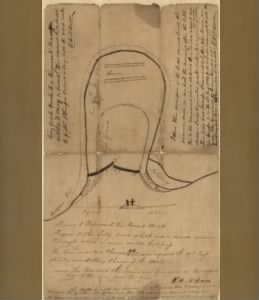
The Battle of Horseshoe Bend is identified with the War of 1812, but it is also the continuation and culmination of the Creek War of 1813-14. The battle took place two hundred years ago this month on a 100-acre peninsula formed by a horseshoe bend in Alabama’s Tallapoosa River.
 On March 27, 1814, Andrew Jackson and his army of about 2,000 soldiers from the East and West Tennessee militias and the 39th U.S. Infantry surrounded the peninsular and 1,000 Creek Indians, known as Red Stick Creek Warriors. The Red Sticks were fighting against European and American expansion and appropriation of their territory. There were also about 600 “friendly” Native Americans, among Jackson’s men, including 100 Creek.
On March 27, 1814, Andrew Jackson and his army of about 2,000 soldiers from the East and West Tennessee militias and the 39th U.S. Infantry surrounded the peninsular and 1,000 Creek Indians, known as Red Stick Creek Warriors. The Red Sticks were fighting against European and American expansion and appropriation of their territory. There were also about 600 “friendly” Native Americans, among Jackson’s men, including 100 Creek.
A couple hours into the battle, a group of Cherokees from Jackson’s ranks swam across the river, stole enemy canoes from the other side, returned for reinforcements, and then paddled back across to burn the village and take women and children prisoners. Jackson’s troops ultimately gained the advantage over the Red Sticks, killing nearly all on the other side. By battle’s end, 557 Creek warriors were dead, another 250-300 more were drowned.
Andrew Jackson was promoted to Major General after the battle and gained a great deal of acclaim which helped propel him to the White House fifteen years later as the seventh president of the United States.
A young Sam Houston, future president of the Republic of Texas wrote of that day: “The sun was going down, and it set on the ruin of the Creek nation. Where, but a few hours before a thousand brave…[warriors] had scowled on death and their assailants, there was nothing to be seen but volumes of dense smoke, rising heavily over the corpses of painted warriors, and the burning ruins of their fortifications.”
Pertinent records on Fold3 include Honor Wall memorials to soldiers who fought at the Battle of Horseshoe bend like John Thrasher, Joseph Beeler and his brother Benjamin, David Beaty’s War of 1812 pension application in which he states he “was at the battle of Horse Shoe,” and index cards for numerous warriors within the final payment vouchers.





My gggrandfather, John White, from Anderson County, Tennessee, fought in this battle at the Horseshoe. Later he migrated with his family to Pike County, Arkansas.